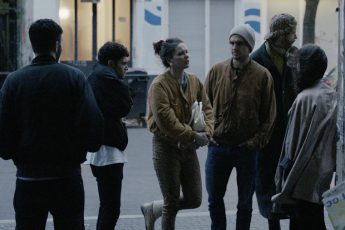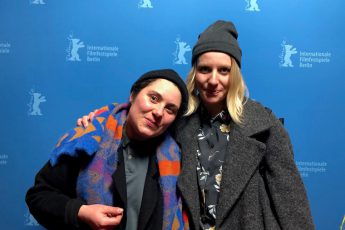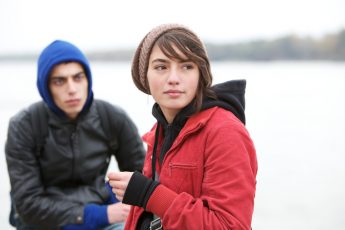
We met Bulgarian filmmaker Tonislav Hristov during the 63rd Thessaloniki International Film Festival (November 3-13), where his debut feature, “The Good Driver”, had its global premiere. The film tells the story of Ivan, a taxi driver who finds himself lost between two worlds. We spoke about the director’s personal ties to the village where the film was shot, the dubious dream of mobility on the European continent and the feeling of togetherness that can be found in small communities.
You have made several documentaries in the past, and you define yourself as a documentary filmmaker. The Good Driver is your first fiction film. Do you feel that nowadays there is a clear distinction to be made between documentary and fiction films?
Actually, I started with a very crazy idea. I wanted to direct two film crews and shoot two films at the same time, one documentary and one fiction film. I thought I could concentrate on the actors and the script with the fiction film, whereas, with the documentary, I could give an extra layer to what’s happening during the shoot. We began filming in the village Golyam Dervent near the Turkish border, where my documentary The Good Postman was also set. The character playing the mayor in the The Good Driver is the “good postman” from the previous film. I would work for eight hours with the “fiction crew” and then another six hours with the “documentary crew,” mainly filming during the night. But very soon I realized that it is very hard, not physically, but because it is extremely tricky to mix actors who are performing a role with real people who are just “playing their lives”. In The Good Driver there are scenes with a documentary flavor, such as the in-between shots that give the audience some extra information about the location and its ambiance, scenes of playing football or walking on the beach. I do not stage my documentaries, but I do prepare thoroughly for them before shoots. I also use real stories and mix them with fictional ones. Even the casting choices had a lot to do with the actors’ real lives. For example, the main actor who plays Ivan, Malin Krastev, and his best friend, played by Gerasim Georgiev, are very good friends in real life as well. I sometimes also improvised, like for example in the scenes where they play football or have ice-cream, or when they go to a karaoke bar in Finland. So, returning to your question, I would say that the major difference is how you work with actors. You cannot ask a non-professional actor to be something else than what she or he already is. So, I work in a sort of hybrid manner, using both fiction and documentary approaches and I feel that there is much more to be discovered in this direction.
The Good Driver picks up themes of migration, marginality, financial hardship, and community, which you had already explored in your 2016 documentary The Good Postman, also set in the small Bulgarian village Golyam Dervent near the Turkish border. What makes you keep returning to this location and community?
Because of migration, I think this village has become a very important place. The majority of migrants that enter Bulgaria use this border crossing and the name of the village, Golyam Dervent, translates as “The Big Doorway”. Actually, a few weeks ago, there was this huge arms trafficking-related accident, with a policeman getting killed. So, in order to shoot in the village, we had to get permission from the border police. The issue of refugees and migration is very present in that place. So, even though many film festivals are not so keen on showing films about migrants anymore, the topic continues to be very important for me personally. This place lies at the crossroads between East and West and at the center of different cultures, of Christians and Muslims; all this in a village of thirty permanent residents. I feel it is dense, it has a strong energy and that is why I have filmed there a lot.
In the post-screening Q&A at Thessaloniki, you explained that the story of Ivan is loosely based on your own biography. You lived in Finland for a number of years. How has this experience influenced your film subjects to date and The Good Driver in particular?
I believe that all the films I have made are personal stories. I always need to find myself in the story. Probably it is the same for all directors. I have a background in engineering, and I made a film, called Love and Engineering, on how engineers find love. For The Good Driver, we already had a script, but I always try to think about what I would do if I were in the character’s situation. I lived in Finland for five to six years and, towards the end, I was going through a very rough time, so I decided to move back to Bulgaria. I come from the countryside and, when I returned there, I realized that the only job I could get was to drive a taxi. This was a real surprise for me since I had a degree in engineering, but driving a taxi is the kind of work that every person can do if they cannot find anything else. We could all end up there at some point in our lives. This also happened to some of my friends, who started working as taxi drivers after graduating from film school. Some of them are still taxi drivers 10 years on.
It is an interesting profession with a social dimension, especially in Eastern Europe. As a passenger, you sit and start talking about all the drama that is going on in your life. It is like a replacement for psychotherapy since we tend to dislike going to professional psychotherapists in Eastern Europe. You may share every detail of your life and then, five minutes later, you just jump out of the cab. I liked the idea of people being in the back seat, sharing their stories and then disappearing. Anyway, I decided that the main character would be a taxi driver who couldn’t make it as a businessman in Finland and who couldn’t make it as a father either. Actually, he couldn’t make it in any area of his life in Finland, because he was afraid of seeing himself being treated as a refugee. Perhaps this is a fear we all share: we are of course proud of who we are, and we do not want to be mistreated.
Among other things, The Good Driver addresses the question of intra-European mobility, people who see the European “north” as a potential solution to their financial (or other) problems. The film seems to reject this idea, showing that Ivan, once bankrupt, would always feel like “the foreign other” in Finland. Still, even if he returns to Bulgaria, he appears to be in-between two countries, never really here or there, something that is further confirmed by the film’s ending. Is there a specific audience you had in mind when you wrote the film’s ending?
I realized that sometimes there is only one place we can really go back to. I like that my characters want to escape to a better place but cannot, because perhaps there is no such place. It is a dream that we’ve had, especially in Eastern Europe. I was born during Communism, so I remember getting MTV or our first Nike sneakers, and we all had this dream about the Western world. Many of my friends, myself included, wanted to try and live in Western Europe. My home city had a population of over a hundred thousand and now this has been reduced to half, because most people live and work somewhere abroad. When you go to “the better world”, it all comes down to two possibilities. You may fail to “make it”, but you are too proud so you will never come back and say “I clean homes in Spain” or “I collect strawberries”. Or, sometimes, you cannot continue anymore and then the only choice is to return and admit to yourself that you have failed. This is the biggest challenge: returning and admitting. My main character, Ivan, did not succeed in the West. He returned, however, with the idea that he would prove to himself that he could still make it. But as his Finnish wife put it in the film, he was just looking for a reason to escape and avoid facing the fact that he had failed, so he abandoned everyone who loved and cared for him. The film’s ending is perhaps dark, but still I wanted to bring back some light in the last scene, which is why the postman calls Ivan and says, “I think I found your refugee family”. It is a sort of redemption.
One could suggest that the core theme of The Good Driver is mobility. For different reasons, Ivan and the refugees from Syria are in constant transit between places, countries, and borders. Is there a specific connection you wanted to make between “financial” migration and the condition of war refugees?
Sometimes people have no choice. People coming from Syria just take their children and whatever they can carry, and they simply run away. Many Eastern Europeans choose to work abroad and leave their children behind at home with their grandparents. For everyone though, migration is all about the hope of a better life, not only for yourself but for your children and the next generation as well. I’m not sure anymore, but some years ago, a better life could indeed be found in democratic countries that have good education and healthcare. I don’t know if I can divide it along the lines of migration for “financial reasons” and migration for “a safe place”, but I think that migrants are people linked by their desire for a better life. In my view, Ivan and the Syrian refugees have similar stories. No one would run if they were comfortable, but the reality is that it is getting harder and harder. At the moment, it is hard being a migrant even in Finland and, because of the war in Ukraine, I do not think that it will get any easier. People are scared, they close off their homes, doors and windows and they don’t feel like offering help.
Could you please comment on your decision to film real refugees and migrants who traveled across the Turkish-Bulgarian border? Were there any ethical issues you had to consider?
There is a scene in which Ivan kicks a refugee family, a mother with her child, out of the car. These are actors, but in the rest of the scenes I filmed real refugees. Initially, I filmed this scene five years ago, because I had to make a demo for a film lab. So, I went to an organization that helps refugees and I described the plot, I explained that the scenes would not be used for another three to four years and I reassured them I would not use any of their real names. There were quite a few people whom we filmed for the scenes inside the taxi. Basically, when they are in Bulgaria, they are allowed to stay here, so as long as you do not film them crossing the border, there is no legal issue. They were paid and they had fun during the shooting, and, being a documentary filmmaker, I was extra careful not to exploit any part of their personal stories. For example, the refugees from Palestine, whom I filmed in one scene, had very interesting personal stories and when the woman started singing a Palestinian song about family and love, I asked her if I could film her singing the song. I felt it was very emotional and important to her, so I kept it as the main soundtrack that runs throughout the scenes where we see refugees alternating in the back seat.
You decided to use both professional and non-professional actors to play in the film. Was your choice motivated by a desire for realism and authenticity?
Going back to the scene with the refugees, I believe it’s very hard to recreate the experience of being a refugee through fiction (say the experience of being stuffed in a car and being driven somewhere). It is a kind of energy that, if you manage to capture it in a documentary, feels stronger than anything that an actor could do in a similar fictional scene. The scene when Ivan kicks the refugees out of the car is strong, but I will tell you a secret. When I did a similar scene with a real refugee family, their fear, their energy, everything was so much stronger. But I could not use it five years later because of script consistency issues. I think this kind of energy that the camera can capture is not something that can be easily performed by actors. Of course, I cannot ask real refugees to be thrown out of a car and get beaten, but whenever it is possible, I prefer realism.
The scenes that capture everyday life in the village are particularly resonant, in particular the portrayal of friendship and solidarity through images of men and women of the village playing football together. Here, your DoP Orlin Ruevski has managed to capture the views in such a way that these seem endowed with a particular moral quality of the cinematic image, which the French filmmaker Jean Epstein has called photogénie. How did you approach filming these particular scenes?
For the football scene, I had two cinematographers whose styles are very different, but they’re both visually strong and that scene was shot somewhat freely. A couple of shots are tightly focused on the players and I was also running around with them while we were filming, because I like the energy of being on set. We have played football together so many times so we just asked everyone, including the boom operator, to run and then we filmed them. I wanted the whole interaction to be three-dimensional, with the camera being able to turn in every direction. I like this kind of sense of everyday life unraveling because it says so much about the place and about the connection between these people. Another example would be the scene where women from the village are cleaning the graveyard. When they play football, when they dream together, when they sing or when they dance; these simple collective moments of these small places rely on their connectedness and this feeling of family and closeness was very important to the story. When Ivan and his friend go to the big city in Finland and they play football with the boys there, there is a kind of warmth between them. In a documentary, you can’t tell non-professional actors to feel or react somehow to a situation, you cannot just place a camera in front of them and ask them to dance. So, before the shooting, I drink with them, we play music and we dance together; it is a slow process of establishing a bond. I like this real emotion and because I have been filming so much in this village these last years, people know me and they trust me. This is why I can ask them to be part of these moments and they know that I am not going to exploit their stories or their lives.
The Good Driver is the second film in your trilogy set in Golyam Dervent. Could you tell us more about the next film?
There is a third film coming that is also filmed in Golyam Dervent, a documentary called The Last Seagull, which is about men hitting on Western women on the Bulgarian seaside, a phenomenon that started in the 1960s. It’s basically Ivan’s life story, whose wife was from Ukraine and whose son now lives there. I had promised myself that I am not going to film in Golyam Dervent anymore, but then the whole war in Ukraine started and I had to go back and change the ending of The Last Seagull. Ivan’s son is still in Ukraine, a country that was now being bombed and I just could not let the film end without including a reference to what happened to him. Anyhow, I am also working on different films with different subjects which will not be set in this village.
Thank you for the interview.




Leave a Comment